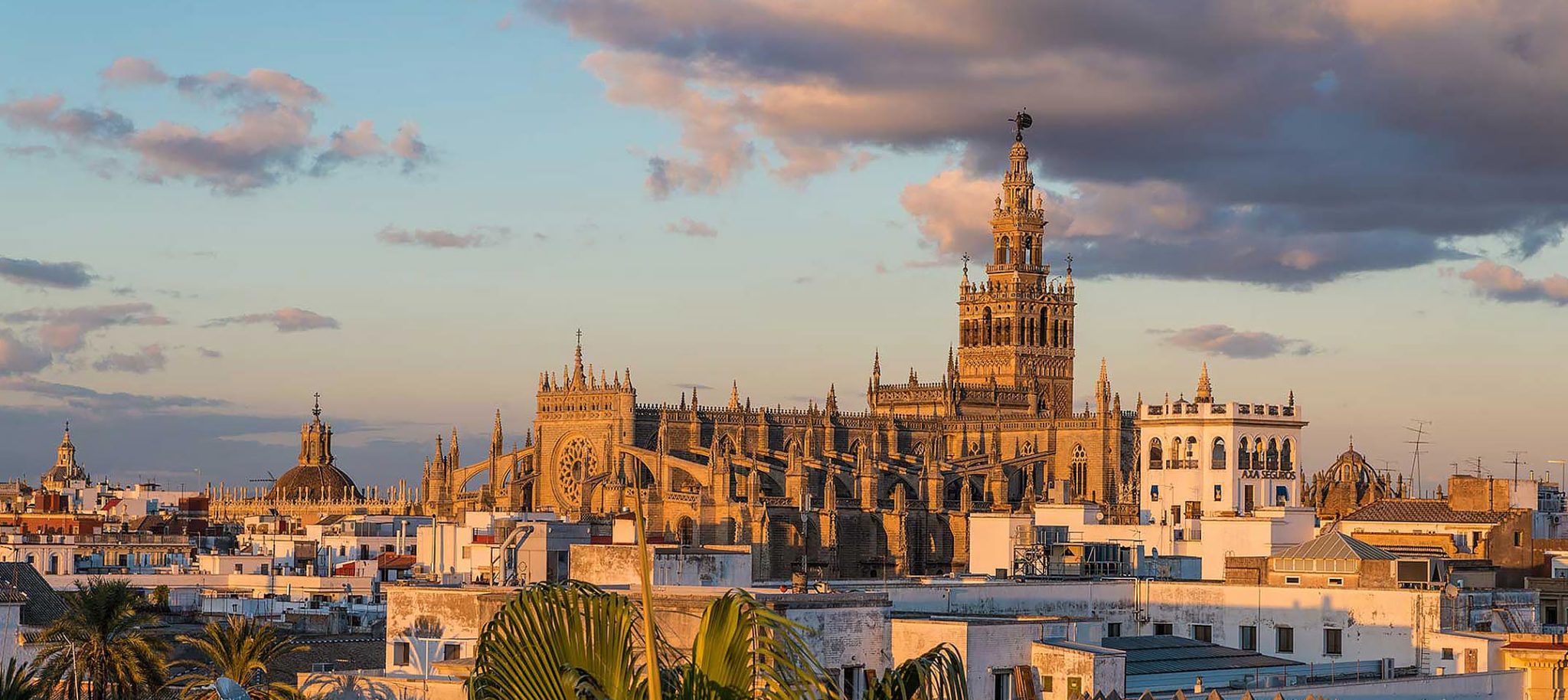The Cathedral of Seville: an Icon of History, Art, and Spirituality
In the heart of the historic center rises one of Spain’s most magnificent monuments: the Cathedral of Seville,considered the largest Gothic cathedral in the world and one of the most iconic treasures of Seville’s heritage. Its imposing structure dominates the city’s skyline and holds within its walls centuries of history, art, and faith.

From mosque to cathedral
When Fernando III of Castile conquered Seville in 1248, the former Great Mosque was converted into a Christian temple. However, the deterioration of the building led the canons to make a bold decision: to build a new cathedral “so large that those who see it will think we are mad,” as tradition states. Thus, at the end of the 15th century, the construction of a monumental temple began, and it was finally consecrated in 1507.
Since then, the Cathedral of Seville has become one of the city’s most recognizable symbols and a UNESCO World Heritage Site (1987), in addition to being designated Property of Outstanding Universal Value (2010).
La Giralda: The Soul of Seville
The skyline of Seville cannot be imagined without La Giralda, the famous bell tower that was originally the minaret of the Almohad mosque, completed in 1182. Its base preserves the elegant features of Islamic architecture, while the upper Renaissance section was added after the Christian conquest.
At the top stands El Giraldillo, a bronze sculpture symbolizing the triumph of the Christian faith. Climbing its ramps (there are no stairs) to enjoy the panoramic views over the city is a must-do experience for every visitor.
The Patio de los Naranjos and the historic gates
Another of the cathedral’s most enchanting spaces is the Patio de los Naranjos, which retains the structure of the former Muslim ablutions courtyard. Rows of orange trees, a central fountain, and horseshoe arches transport visitors back in time.
From this courtyard, visitors can enter through several gates, including the Puerta del Perdón, the oldest of all, richly decorated with Mudejar reliefs. In total, the cathedral has ten gates, each with its own story. The Puerta del Príncipe, opening onto Plaza del Triunfo, is one of the most frequented, while the monumental Puerta de la Asunción, located on the main façade, is particularly impressive.
Artistic and spiritual treasures
The interior of the Cathedral of Seville is just as awe-inspiring as its exterior. Among its highlights is the Tomb of Christopher Columbus, an imposing sculptural work where four heralds representing the ancient kingdoms of Castile, León, Aragon, and Navarre carry the explorer’s coffin.
Another focal point is the Main Altarpiece (Retablo Mayor), considered the largest altarpiece in Christendom. Designed by Pedro Dancart, it features more than two hundred carved figures depicting biblical scenes with extraordinary detail. At the center stands the Virgin of the See, protector of the cathedral.
Also notable is the Royal Chapel (Capilla Real), where monarchs such as Fernando III, Alfonso X, and Pedro I are buried. Here, the beloved Virgin of the Kings (Virgen de los Reyes), patron saint of Seville, is venerated by locals.
A Cathedral as a Museum of Art
Exploring the cathedral is also a journey through the history of Spanish art. In its 25 chapels, masterpieces by renowned artists such as Murillo, Zurbarán, Herrera el Mozo, and Alonso Cano are preserved. One of the most celebrated paintings is Murillo’s “The Vision of Saint Anthony”, along with numerous Baroque altarpieces and Gothic sculptures that adorn every corner.
The choir features a stunningly carved wooden choir stall and two twin organs, enhancing the solemn atmosphere of the temple. Every detail invites visitors to pause, observe, and understand why the Cathedral of Seville is truly a living museum.
Itineraries and curiosities
A typical visit begins at the main façade, continues through the Patio de los Naranjos, and culminates with the ascent to La Giralda. From the top, Seville unfolds in all its splendor: white rooftops, the Torre del Oro, the Alcázar, and the Guadalquivir River shaping a landscape where history and modernity coexist.
Inside, visitors can also admire unique relics such as the Pendón de San Fernando, the banner with which the king conquered the city, displayed opposite the Church of the Sagrario.
To make the most of the experience, it’s recommended to book tickets or guided tours in advance through the official website of the Cathedral of Seville or through specialised agencies such as Civitatis, which offer guided tours in different languages and at different times.
Where to Stay to Explore the Cathedral of Seville
After a day discovering this majestic temple, there’s nothing better than resting in a place that combines comfort, style, and a privileged location. For this, Hidden Hotels offers two exceptional options for those wishing to experience Seville from its vibrant heart.
Gravina 51, is a luxury boutique hotel in Seville, is just a short walk from the Cathedral. Its elegant rooms, personalized service, and palatial ambiance make it the perfect base for exploring major landmarks, enjoying local gastronomy, and embracing the charm of the historic center.
Meanwhile, Cavalta Boutique Hotel, located in the heart of Triana, is ideal for travelers seeking the most authentic essence of Seville, surrounded by history, art, and flavor. Its restaurant, Balbuena y Huertas, reimagines Andalusian tradition with refined technique and a passion for local produce and author cuisine. It has become one of the best restaurants in Triana, where every dish celebrates culinary heritage and artistry.
Both hotels offer the perfect blend of comfort, design, and authenticity, turning a cultural getaway to Seville into an unforgettable experience.

